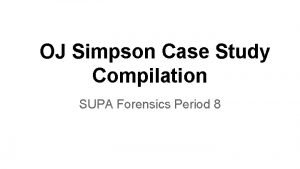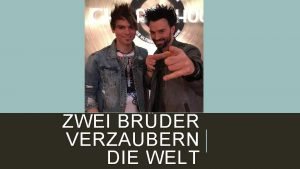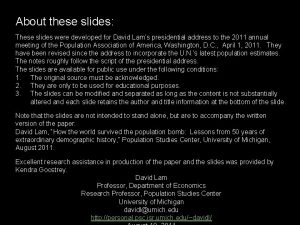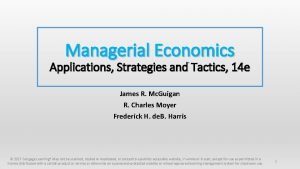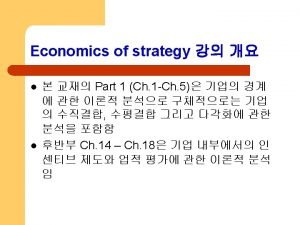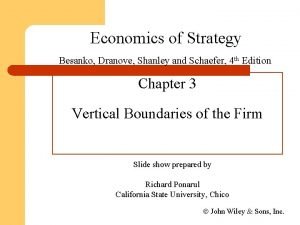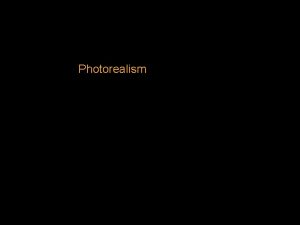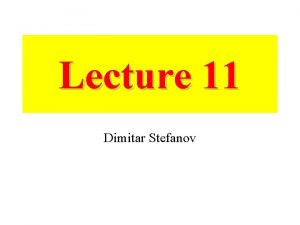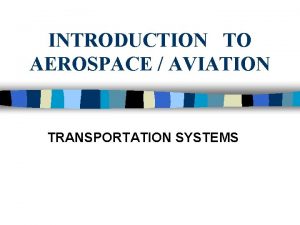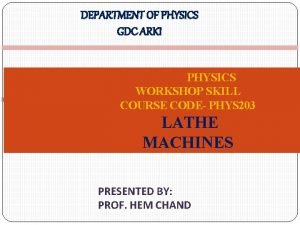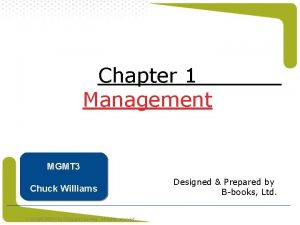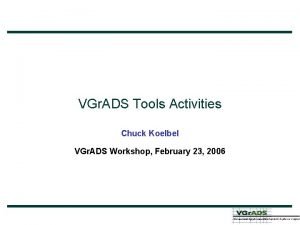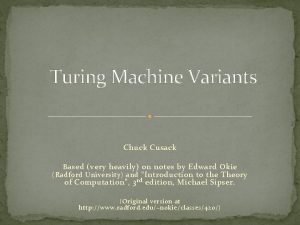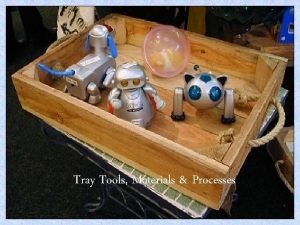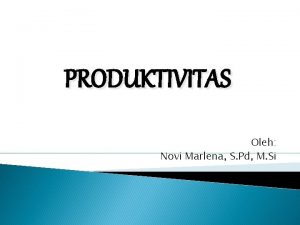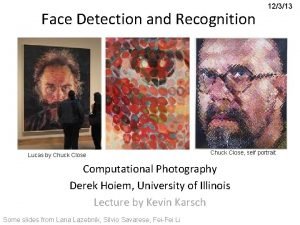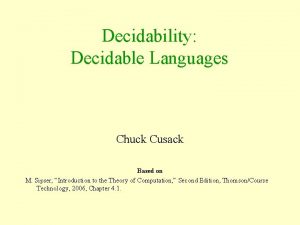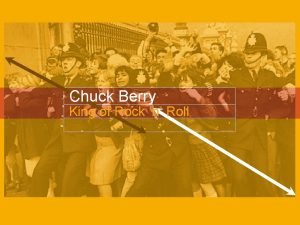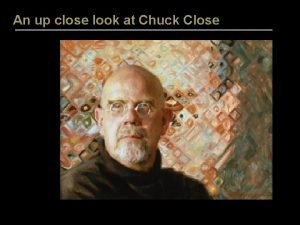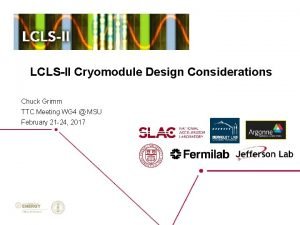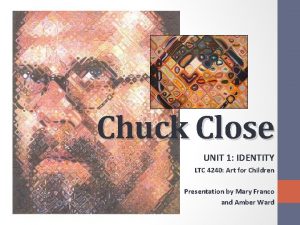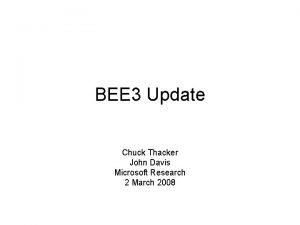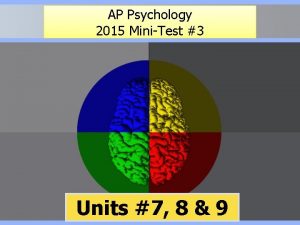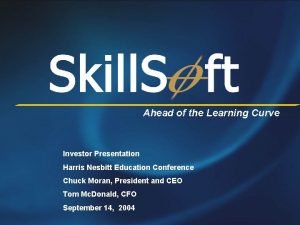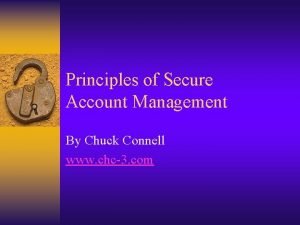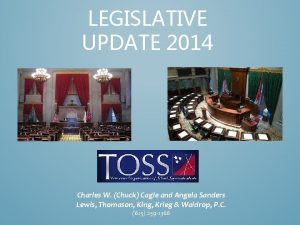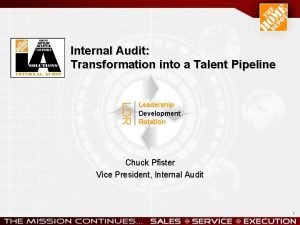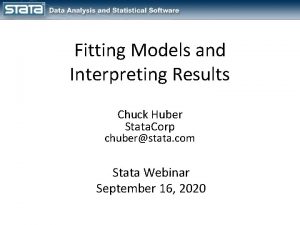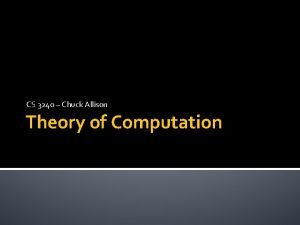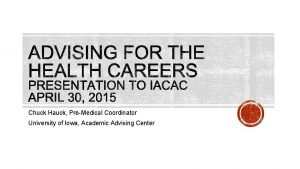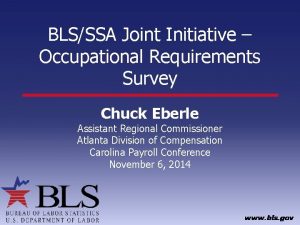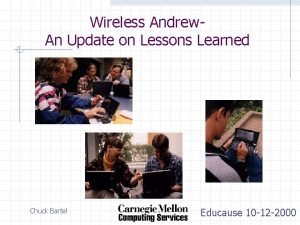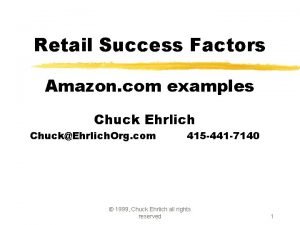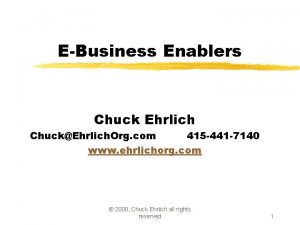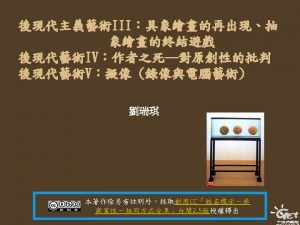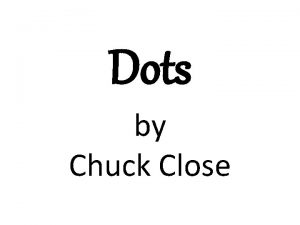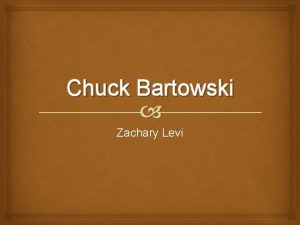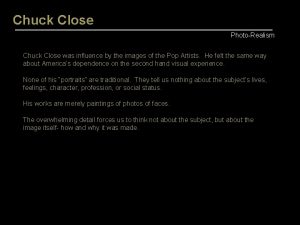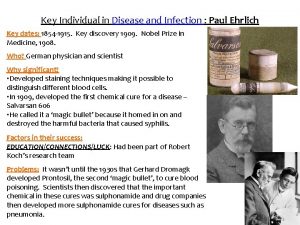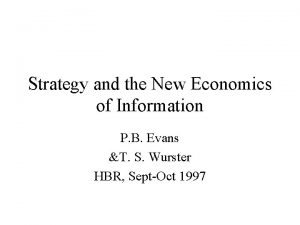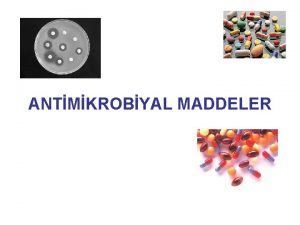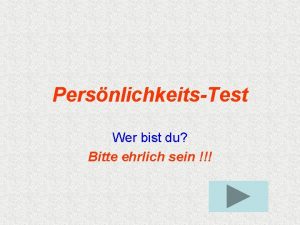New Economics of Information and Strategy Chuck Ehrlich


















































- Slides: 50

New Economics of Information and Strategy Chuck Ehrlich Chuck@Ehrlich. Org. com 1 -415 -441 -7140 www. ehrlichorg. com © 1999, Chuck Ehrlich all rights reserved 1

Information z. Every business is an information business z. For example y. Health care spends 1/3 or $350 b on costs associated with information capture, processing, etc. y. Manufacturing is shaped by information y. Even low tech products require market research, logistics and advertising © 1999, Chuck Ehrlich all rights reserved 2

Information is not just data y. Includes qualitative judgments, affiliation, emotion are shared along with numbers and facts y. Denotation and connotation are inseparable © 1999, Chuck Ehrlich all rights reserved 3

Information is the glue Holding together z. Value chains and supply chains z. Consumer franchises z. Organizations © 1999, Chuck Ehrlich all rights reserved 4

Inventory y. Physical correlate of deficient information © 1999, Chuck Ehrlich all rights reserved 5

Corporations z. Held together by informational logic y. Certain kinds of information can be shared more efficiently within the boundaries of the corporation than across them z. Organized around information flows y. Organizational structures are information channels © 1999, Chuck Ehrlich all rights reserved 6

Industries z. Shaped by the same kind of informational logic as the value chains within companies ybut in a weaker form © 1999, Chuck Ehrlich all rights reserved 7

Brands z. Information consumers associate with a product y. Real or imagined z. Brand building tools are information channels y. Advertising, promotion, sales pitch, presentation © 1999, Chuck Ehrlich all rights reserved 8

Competitive advantage z. Comes from information y. Toyota engineering, kanban, quality control y. American Airlines SABRE y. Wal-Mart logistics y. Coca Cola brand management © 1999, Chuck Ehrlich all rights reserved 9

Different economics Things z Seller looses thing z Manufacturing costs z Wears out z Exists in a location Information z Seller retains z Free copies z Never wears out z Everywhere and no where © 1999, Chuck Ehrlich all rights reserved 10

Economic returns z. Things y. Diminishing returns ex. Agriculture y. Increasing returns ex. Factories z. Information y. Perfectly increasing returns xdouble the uses and halve the cost per use © 1999, Chuck Ehrlich all rights reserved 11

Economic markets z. Things: consistent with Efficient Markets z. Information: requires Imperfect Markets y. Ability to limit access through copyright, patent or secrecy is essential y. Without access limits information is worthless y. With limits, information is a monopoly © 1999, Chuck Ehrlich all rights reserved 12

Economics z. Fundamentally and qualitatively different for Things and Information z. Information embedded within a Thing has mixed economics © 1999, Chuck Ehrlich all rights reserved 13

Traditional links z. Between rich information and carrier y. The medium and the message y. Product related information and product itself y. Informational value chain and the physical value chain Blend economics of information and things in compromised bundles © 1999, Chuck Ehrlich all rights reserved 14

Links are being broken z. By connectivity z. Information can travel by itself z. Unbundling the economics of information and things © 1999, Chuck Ehrlich all rights reserved 15

Compromises=vulnerability z. Retail groceries y. Low product value, high inventory turnover y. Premium placed on selection is low y. Low tension between selection and inventory z. Book retailing y. Informational imperative for a large inventory y. Logistic imperative to minimize inventory y. Strong tension and suppressed value © 1999, Chuck Ehrlich all rights reserved 16

Richness and reach z. Information delivered physically is subject to a universal trade-off between richness and reach y. Richness—quality of information, accuracy, bandwidth currency, interactivity, etc. y. Reach—number of people who participate in sharing information © 1999, Chuck Ehrlich all rights reserved 17

Richness and reach © 1999, Chuck Ehrlich all rights reserved 18

Richness and reach: positioning © 1999, Chuck Ehrlich all rights reserved 19

Asymmetries of information z. Differences in knowledge that affect bargaining power z. For example selling a used car y. Seller knows condition y. Naïve buyer may not know condition or value y. Professional buyer has more information © 1999, Chuck Ehrlich all rights reserved 20

Asymmetries of information z. Lack of information, or trust, breaks deals z. Asymmetries impose costs on the disadvantaged participant y. And often on the advantaged as well z. Many asymmetries arise from richness/reach tradeoffs © 1999, Chuck Ehrlich all rights reserved 21

Richness and reach z. Information channels imply asymmetries y. Some have access and others don’t y. Those with access use information to extract value from those without z. Eliminate the richness/reach tradeoff, make the channel accessible, and eliminate the asymmetry © 1999, Chuck Ehrlich all rights reserved 22

Connectivity & standards z. Drivers behind the blowup of the richness/reach trade-off: y. Connectivity: the Internet, lower cost networks, higher speeds y. Standards: Web standards, Internet standards, Application Standards, Database standards, etc. z. Enabling new levels of richness and reach © 1999, Chuck Ehrlich all rights reserved 23

Deconstruction z. Dismantling traditional business structures as a result of y. Separating the economics of information and the economics of things y. Blowing up of the trade-off between richness and reach z. Reformulating new business structures ybased on the separate economics of information and things © 1999, Chuck Ehrlich all rights reserved 24

Example: newspapers before z. Vertically and horizontally integrated value chain z. Intermediary y. Linking journalists and readers z. Bundle sharing cost and revenues y. Classifieds, display ads, news, features, cartoons, etc. © 1999, Chuck Ehrlich all rights reserved 25

Example: newspapers after z. Unbundled y. Weather online y. E-mail news y. Classifieds replaced by e. Bay or online ads z. Classifieds: 40% of revenue, 10% of costs y. Enough to financially destabilize most papers © 1999, Chuck Ehrlich all rights reserved 26

Deconstruction z. A little can do lots of damage z. Always strikes where the incumbent can least afford it Insurgent’s greatest advantage is the incumbents unwillingness to fight on a deconstructed basis © 1999, Chuck Ehrlich all rights reserved 27

Reconstruction z. Follows deconstruction using new business definitions z. Navigators (see below) emerge as a new y. Function y. Industry y. Competitive opportunity © 1999, Chuck Ehrlich all rights reserved 28

Example: retail banking © 1999, Chuck Ehrlich all rights reserved 29

Example: retail banking © 1999, Chuck Ehrlich all rights reserved 30

Example: retail banking z. Profitability is driven by assets, income, and number of transactions z. Users of personal financial software above average in all measures y 12% of households y 75% of banking profits © 1999, Chuck Ehrlich all rights reserved 31

Example: automobile sales z. Before: dealers z. After: online brokers y. Autobytel, Auto. Vantage, Car. Max, Car. Point © 1999, Chuck Ehrlich all rights reserved 32

Types of deconstruction z. Break into value chain components z. Break along vertical links y. Suppliers, customers, & consumers z. Segregation of information flows into their own business z. Organizational relations renegotiated y. Employees, investors, & entrepreneurs © 1999, Chuck Ehrlich all rights reserved 33

Effects of deconstruction z. Competitive advantage is de-averaged y. Fragment into multiple businesses y. Most profitable parts are most vulnerable z. Escalating competition y. Fewer ways to win y. Monolithic advantage breed monopoly © 1999, Chuck Ehrlich all rights reserved 34

Effects of deconstruction z. Information businesses have value y. Source of competitive advantage and profit z. New opportunities for physical business y. Shipping companies with e-commerce y. Supermarkets as retail banks z. Wholesalers, retailers, distributors will be disintermediated © 1999, Chuck Ehrlich all rights reserved 35

Information business is different z. Physical business: economies of scale, segmentation, operational effectiveness z. Information business: y. Setting standards, preemptive critical mass, controlling patents and copyrights, alliances, new technologies, changing business boundaries y. Race for monopoly position, winner take all © 1999, Chuck Ehrlich all rights reserved 36

Navigators emerge z. Software: Quicken z. Databases: Auto Trader z. Evaluators: Consumer Reports, JD Power z. Search engines: Yahoo! z. People: financial advisors Also known as Infomediaries © 1999, Chuck Ehrlich all rights reserved 37

Navigators z. Look like small business z. Provide the leverage for competitive advantage z. Drive fundamental power shifts among other players © 1999, Chuck Ehrlich all rights reserved 38

Navigators z. New function z. New industry z. New competitive opportunity z. Will appropriate most of the value © 1999, Chuck Ehrlich all rights reserved 39

Disintermediation © 1999, Chuck Ehrlich all rights reserved 40

Online Brokers © 1999, Chuck Ehrlich all rights reserved 41

Computer retailing © 1999, Chuck Ehrlich all rights reserved 42

Hierarchical Search: crawling up the trade-off © 1999, Chuck Ehrlich all rights reserved 43

New world of navigation z. Infinite choice z. Negligible searching (and switching) costs z. Fluidity z. Lack of a center (no hub) z. Adaptability z. Competition on affiliation, reach, richness © 1999, Chuck Ehrlich all rights reserved 44

Affiliation z. Reach constraints make navigators specific to sellers z. Without constraints, navigators affiliate with buyers z. Agency shift will force all players to shift their navigation offerings closer to consumer affiliation and greater reach © 1999, Chuck Ehrlich all rights reserved 45

Richness z. Rich about the consumer: segment of one z. Rich about the product: services, etc. z. Adding richness forestalls deconstruction z. Privacy is the Achilles’ Heel of the information economy z. Consumer as competitor y. What are you doing for her that she cannot do for herself? © 1999, Chuck Ehrlich all rights reserved 46

Richness z. Value of sellers’ richness goes up as reach increases y. Grab attention z. Value of seller’s richness goes down as navigators’ richness catches up © 1999, Chuck Ehrlich all rights reserved 47

Summary z. Expect business definitions to change z. Deconstruction strikes where incumbents have the most to lose z. Waiting for someone else to demonstrate the feasibility of deconstruction gives the advantage of time to competitors. © 1999, Chuck Ehrlich all rights reserved 48

Summary z. Strategy really matters z. Value of winning increases, as does the cost of losing z. Incumbents can be insurgents, if they choose. But its hard. © 1999, Chuck Ehrlich all rights reserved 49

For more information z. Blown to Bits how the new economics of information transforms strategy by Philip Evans and Thomas Wurster, Harvard Business School Publishing, 2000 z. Other information at www. ehrlichorg. com including references and course materials © 1999, Chuck Ehrlich all rights reserved 50
 Cynthia shahian
Cynthia shahian Chris reinelt frau
Chris reinelt frau Paul ehrlich
Paul ehrlich Ralf ehrlich
Ralf ehrlich Detoxamin side effects
Detoxamin side effects Verzahnungsarten
Verzahnungsarten Spare receptors
Spare receptors School of business and economics maastricht
School of business and economics maastricht Mathematical vs non mathematical economics
Mathematical vs non mathematical economics Managerial economics applications strategy and tactics
Managerial economics applications strategy and tactics The opportunities and challenges of media and information
The opportunities and challenges of media and information How to find a nash equilibrium
How to find a nash equilibrium Economics of strategy besanko
Economics of strategy besanko Economics of strategy besanko
Economics of strategy besanko Corporate strategy and business strategy
Corporate strategy and business strategy What is a chase strategy
What is a chase strategy Chuck close linda
Chuck close linda 3 jaw chuck grasp examples
3 jaw chuck grasp examples Aviation
Aviation Bernoulli chuck
Bernoulli chuck 3 jaw chuck grasp examples
3 jaw chuck grasp examples Management by chuck williams
Management by chuck williams Castaway character
Castaway character Chuck baird paintings
Chuck baird paintings Chuck tolbert
Chuck tolbert Network chuck kasm
Network chuck kasm Chuck cusack
Chuck cusack Pillar seed drill
Pillar seed drill Contoh soal produktivitas multifaktor
Contoh soal produktivitas multifaktor Lucas by chuck close
Lucas by chuck close Chuck cusack
Chuck cusack Chuck close fanny
Chuck close fanny Chuck berry
Chuck berry Chuck close childhood
Chuck close childhood Chuck grimm
Chuck grimm Chuck close youtube
Chuck close youtube Chuck close
Chuck close Chuck thacker
Chuck thacker According to jean piaget children cease to exhibit
According to jean piaget children cease to exhibit Marc performs poorly on a psychology exam
Marc performs poorly on a psychology exam Chuck moran skillsoft
Chuck moran skillsoft Chuck connell
Chuck connell Chuck allison
Chuck allison For lathe operations, work piece can be hold _____
For lathe operations, work piece can be hold _____ Chuck cagle
Chuck cagle Chuck pfister
Chuck pfister Chuck huber stata
Chuck huber stata Chuck allison
Chuck allison Chuck hauck
Chuck hauck Chuck eberle
Chuck eberle Chuck bartel
Chuck bartel
